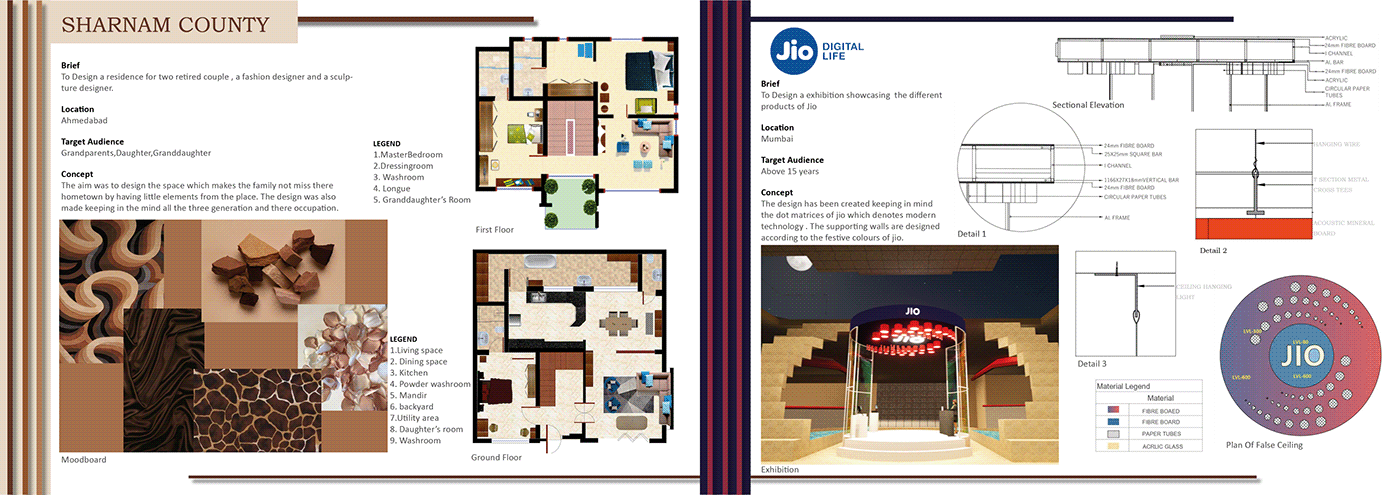Creating an interior design portfolio is like crafting your unique fingerprint in the design world. It's your chance to showcase your creativity, style, and expertise. Think of it as your calling card—a visual representation of who you are as a designer and what you can offer to potential clients. Whether you're a seasoned designer or just starting, a well-structured portfolio can open doors to exciting opportunities and collaborations.
Why Choose Behance for Your Portfolio

Behance is a fantastic platform for showcasing your interior design projects. But why should you choose it over other platforms? Let’s dive into some of the compelling reasons:
- Vibrant Community: Behance is home to a thriving community of artists and designers. By sharing your work here, you can connect with fellow creatives, receive feedback, and even collaborate on projects.
- User-Friendly Interface: The platform offers an intuitive design that makes uploading and organizing your projects a breeze. You can create visually stunning presentations without needing advanced technical skills.
- Exposure to Industry Professionals: Many recruiters and art directors use Behance to discover talent. Having your portfolio on this platform increases your chances of being noticed by potential clients and employers.
- Customizable Project Pages: Behance allows you to tailor each project page to reflect your style. You can include images, videos, and even project descriptions to give viewers a comprehensive understanding of your work.
- Integrated Social Features: With options to follow other creators, appreciate their work, and comment, Behance fosters a sense of community and interaction that can enhance your visibility.
In summary, Behance isn’t just a portfolio site; it’s a creative hub. By choosing this platform, you're not only showcasing your work but also immersing yourself in a world of inspiration and opportunity.
Also Read This: How to Download Mockups on Behance: Easy Steps to Get the Files You Need
3. Steps to Creating Your Behance Portfolio

Creating a stunning Behance portfolio is a straightforward process that can significantly elevate your visibility as an interior designer. Let’s break it down into manageable steps:
- Sign Up or Log In: If you don’t already have a Behance account, head over to the Behance website and sign up. If you’re an existing user, simply log in. You’ll want to ensure that your profile is complete with your name, photo, and a brief bio that reflects your design philosophy.
- Navigate to Your Profile: Once logged in, go to your profile page. This is where all the magic happens. Click on the “Create a New Project” button to start showcasing your work.
- Choose a Project Type: Behance allows you to present your projects in various formats. Decide whether you want to upload images, videos, or even a PDF. For interior design, high-quality images and mood boards work wonders. Ensure your visuals are bright, well-lit, and showcase your designs effectively.
- Upload Your Work: Begin by dragging and dropping your images or selecting them from your computer. Aim for a cohesive look; this might mean sticking to a particular color palette or style across your images. You can create sections for different aspects of your project, like “Concept,” “Execution,” and “Final Outcome” to guide your viewers through your process.
- Add Descriptions: Each image deserves a caption! Use this space to explain your design choices, the challenges you faced, and the solutions you implemented. This storytelling aspect adds depth to your portfolio, allowing potential clients to understand not just what you did, but how you think.
- Utilize Tags: Tags make your work more discoverable. Use relevant keywords like “Interior Design,” “Home Decor,” or specific styles like “Scandinavian” or “Mid-Century Modern.” This will help potential clients or collaborators find your work when they search for specific styles.
- Publish and Share: Once you’re satisfied with your project, hit the “Publish” button. Share your newly created portfolio on social media platforms and with your network to gain traction. The more visibility, the better!
By following these steps, you’ll create a visually appealing and informative Behance portfolio that can help you stand out in the competitive world of interior design. Remember, your portfolio is a reflection of your style and capabilities, so make it shine!
Also Read This: How to Change Your Behance Web Slug: Customizing Your Portfolio’s URL Slug
4. Choosing the Right Projects to Showcase

Now that you know how to create a Behance portfolio, the next crucial step is deciding which projects to feature. Not every project you’ve worked on needs to make the cut; you want to showcase your best work that truly reflects your design aesthetic and skills. Here’s how to choose wisely:
- Quality Over Quantity: It's tempting to include every project, but focus on a select few that highlight your strengths. Aim for 5-10 of your best pieces. Each should demonstrate your unique style and capabilities.
- Diversity of Work: Showcase a range of styles and types of projects. If you've worked on residential, commercial, and hospitality designs, include examples from each category. This shows your versatility and ability to adapt to different client needs.
- Recent Projects: Highlight your most recent work first. This reflects your current style and skills, which is essential in the ever-evolving world of design. Clients want to see what you can do now, rather than what you did years ago.
- Projects with Strong Narratives: Choose projects where you faced significant challenges or where you implemented innovative solutions. These stories not only engage viewers but also highlight your problem-solving skills.
- Feedback and Results: If any of your projects received positive feedback or won awards, make sure to include them. Demonstrating the impact of your designs can significantly boost your credibility.
In conclusion, selecting the right projects for your Behance portfolio is about blending your best work with a variety of styles and narratives. This curated approach not only showcases your skills but also tells a compelling story of your journey as an interior designer. Happy designing!
Also Read This: Mastering Keywords for Shutterstock: Enhancing Discoverability and Increasing Sales
5. Designing an Eye-Catching Portfolio Layout
Creating a portfolio that stands out on Behance is all about layout. Think of your portfolio as your personal gallery; it should reflect your unique style and creativity. Here’s how you can design a visually appealing layout that captures attention:
- Choose a Clean and Simple Structure: A cluttered design can distract from your work. Opt for a minimalist approach with plenty of white space. This allows your projects to breathe and your audience to focus on the details.
- Use Consistent Branding: Incorporate your brand colors, fonts, and logos throughout your portfolio. This creates a cohesive look that reinforces your identity as a designer.
- Showcase Featured Projects: Highlight your best work at the top of your portfolio. This could be a carousel or grid layout showcasing one or two standout projects. Use high-quality images that display your design skills.
For example, if you’re a residential designer, you might want to feature a stunning living room transformation as your hero project. Include before-and-after images to illustrate your impact clearly!
Interactive Elements: Consider adding interactive features like hover effects or lightboxes. These elements can enhance the user experience, making it fun for visitors to explore your work. Just ensure they don’t overpower the content.
Organize by Categories: If you have multiple types of projects—like commercial, residential, and product design—create separate sections for each category. This helps viewers navigate your portfolio easily and find what interests them.
Lastly, remember to test your layout on different devices. A responsive design ensures that your portfolio looks great on both desktop and mobile, reaching a wider audience. With these tips, you’ll create a stunning portfolio layout that captures attention and showcases your design prowess beautifully.
Also Read This: How to Create Project in Behance: A Guide to Showcasing Your Creative Projects
6. Writing Descriptions that Engage and Inform
Now that your layout is on point, let’s dive into the words that will accompany your stunning visuals. Descriptions play a crucial role in conveying the story behind your projects. Here are some tips to craft engaging and informative descriptions:
- Start with a Hook: Your first sentence should grab attention! Instead of jumping straight into details, consider starting with a thought-provoking question or a bold statement about the project. For example, “What if a small apartment could feel as spacious as a mansion?”
- Provide Context: Briefly describe the project’s goal, your role, and any challenges you faced. This gives viewers insight into your design process. For instance, “In this project, I aimed to transform a cramped studio into a functional and stylish living space for a young professional.”
- Highlight Your Design Choices: Explain why you made certain design decisions. If you chose a specific color palette or material, share your reasoning. This not only informs your audience but also showcases your design thinking.
For instance, you might say, “I chose a monochromatic color scheme to enhance the feeling of space while incorporating natural wood accents to add warmth.”
Use Engaging Language: Write in a conversational tone that reflects your personality. Avoid jargon unless it’s necessary, and aim for clarity. Your descriptions should feel friendly and approachable.
Don’t Forget Your Audience: Tailor your language to your target audience. If you’re aiming to attract potential clients, focus on how your designs solve their problems or enhance their lives. If you’re targeting fellow designers, you might delve into technical aspects or trends.
Finally, keep your descriptions concise. Aim for 2-4 paragraphs that capture the essence of each project. This way, visitors can easily digest your work without feeling overwhelmed. With engaging descriptions, your portfolio will not only showcase your designs but also tell compelling stories that resonate with your audience!
Also Read This: How to Hide Your Behance Works: Control Access to Your Creative Projects
7. Promoting Your Portfolio Effectively
Now that you’ve crafted a stunning interior design portfolio on Behance, it’s time to get the word out! Promotion is key to attracting potential clients and showcasing your talent. Here are some effective strategies to promote your portfolio:
- Leverage Social Media: Share your projects on platforms like Instagram, Pinterest, and Facebook. Use engaging visuals and relevant hashtags to reach a broader audience. For instance, post snippets of your design projects on Instagram Stories with a direct link to your Behance portfolio.
- Network with Other Designers: Connect with fellow designers, attend industry events, or join online forums. Engaging with your peers can lead to collaborations and mutual promotions. Consider joining Facebook groups or LinkedIn communities focused on interior design.
- Utilize Email Marketing: Create a newsletter featuring your latest projects and insights. Encourage sign-ups on your Behance profile and send regular updates to your subscribers, keeping them engaged with your work.
- Participate in Design Challenges: Behance often hosts design challenges. Entering these not only gives you exposure but also places your work in front of a judging panel, which can lead to valuable feedback and recognition.
- Collaborate with Influencers: Partnering with social media influencers in the design space can amplify your reach. A simple shout-out or review of your portfolio could bring in new followers and potential clients.
Additionally, don't underestimate the power of SEO! Optimize your portfolio with keywords related to your design style and services. This can help your portfolio show up in search results when potential clients are looking for designers.
Lastly, consider creating a personal blog or website that links back to your Behance portfolio. This not only helps establish your brand but also gives you another platform to showcase your expertise and projects.
8. Tips for Keeping Your Portfolio Updated
In the ever-evolving world of interior design, keeping your portfolio fresh and relevant is crucial. An outdated portfolio can misrepresent your current style and skills. Here are some practical tips for maintaining an up-to-date interior design portfolio:
- Set a Regular Update Schedule: Mark your calendar to review your portfolio every few months. This could be a quarterly or bi-annual task. Regular updates ensure you’re showcasing your best and most recent work.
- Remove Older Projects: As you gain experience, some older projects may no longer reflect your current capabilities. Don’t hesitate to remove or archive these works to make space for new ones that showcase your growth.
- Incorporate New Skills: If you’ve learned new design techniques or software, incorporate projects that reflect these skills. For example, if you’ve recently mastered 3D rendering, showcase a project that highlights this ability.
- Gather Feedback: Seek constructive criticism from peers, mentors, or even clients. Fresh perspectives can help you identify which projects to highlight and how to present them more effectively.
- Stay Current with Trends: Keep an eye on the latest design trends and incorporate them into your work. If you’ve updated your portfolio to reflect contemporary styles, it shows potential clients that you’re in tune with the market.
Lastly, don’t forget to refresh the look and feel of your portfolio occasionally. A new layout or design can breathe life into your existing projects and keep your audience engaged. Remember, your portfolio is a reflection of you as a designer—keep it vibrant and true to your evolving style!
 admin
admin








